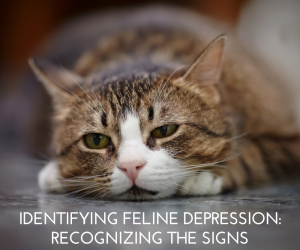 Feline companions bring joy and comfort to our lives, but just like humans, they can experience emotional challenges, such as depression. As responsible pet owners, it’s crucial to be attuned to our cats’ emotional well-being. In this blog post, we will delve into the topic of feline depression, exploring the signs to watch out for and providing insights into how to recognize if your beloved furry friend might be struggling.
Feline companions bring joy and comfort to our lives, but just like humans, they can experience emotional challenges, such as depression. As responsible pet owners, it’s crucial to be attuned to our cats’ emotional well-being. In this blog post, we will delve into the topic of feline depression, exploring the signs to watch out for and providing insights into how to recognize if your beloved furry friend might be struggling.
Understanding Feline Depression:
Feline depression, also known as cat depression, is a real concern that affects many cats, often triggered by changes in their environment, routine, or health. Cats are known for their independent nature, but they still form strong emotional bonds with their human caregivers. Disrupting these bonds can lead to feelings of sadness and withdrawal in cats.
Signs of Feline Depression:
Changes in Eating Habits: One of the most noticeable signs of feline depression is a sudden change in appetite. A depressed cat might lose interest in food or overeat as a way of coping.
Lethargy and Reduced Activity: Depressed cats tend to become lethargic and less interested in play or interacting with their surroundings. If your once-active cat becomes increasingly inactive, it could be a sign of depression.
Hiding and Isolation: Cats may seek solitude when they’re feeling down. If your usually sociable cat starts hiding in unusual places and avoids interaction, it might be indicative of depression.
Changes in Grooming Habits: Cats are meticulous groomers, so a noticeable decrease in grooming could point to emotional distress.
Vocal Changes: Some cats become more vocal when they’re depressed, while others may become unusually quiet. Both extremes could signal emotional turmoil.
Avoiding Litter Box: Depression might lead to changes in litter box behavior. A depressed cat might start avoiding the litter box, indicating their distress.
How to Help a Depressed Cat:
Consult a Veterinarian: Before assuming your cat is depressed, it’s important to rule out any potential medical issues. A visit to the veterinarian can help confirm the diagnosis and rule out other health concerns.
Create a Comforting Environment: Ensure your home environment is conducive to your cat’s emotional well-being. Provide hiding spots, perches, and comfortable resting areas.
Maintain Routine: Cats thrive on routine. Try to maintain consistent feeding times, play sessions, and social interactions.
Engage in Play: Interactive play is crucial in boosting your cat’s mood. Use toys that mimic hunting behavior to keep them engaged and stimulated.
Spend Quality Time: Spend dedicated time with your cat, engaging in gentle grooming, petting, and talking to them. Your presence and attention can go a long way in alleviating their depression.
Feline depression is a serious issue that shouldn’t be ignored. As responsible pet owners, it’s our duty to recognize the signs and provide the necessary care and support for our beloved feline friends. By understanding the signs and taking appropriate steps to help our cats through their emotional challenges, we can ensure their overall well-being and happiness. If you suspect your cat is suffering from depression, don’t hesitate to seek guidance from Guildcrest Cat Hospital or animal behaviorist. Your furry friend deserves all the love and care in the world.
